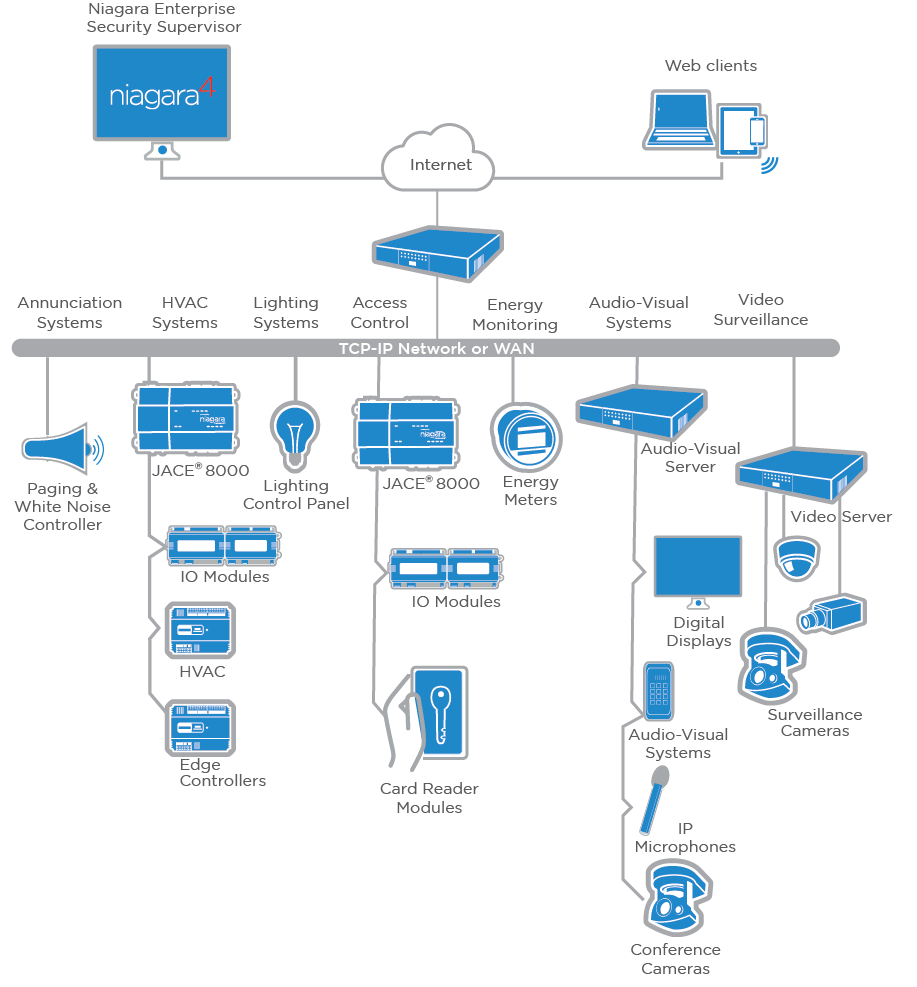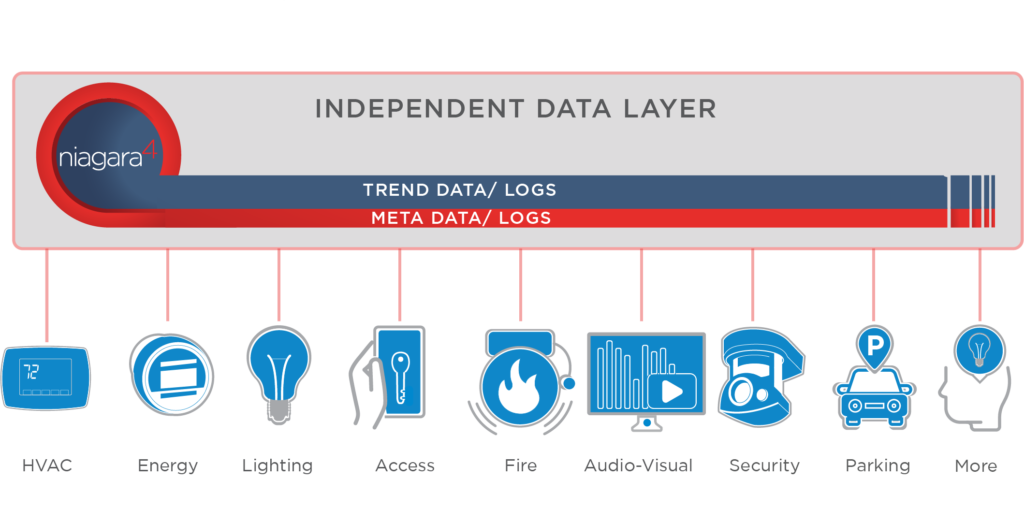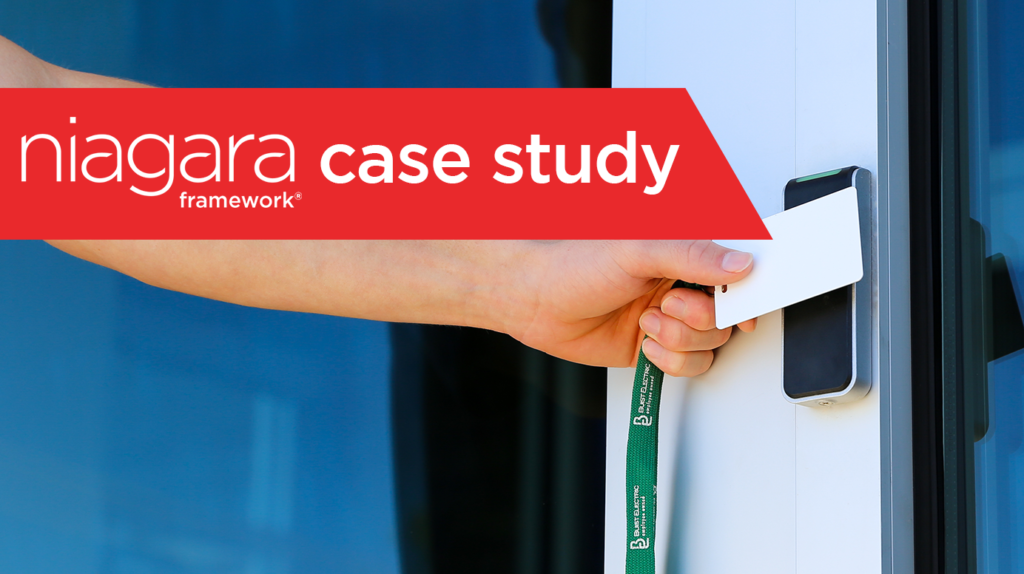Buist Electric (https://buistelectric.com/) is a diverse electrical company specializing in engineering, design, and installation of electrical and electronic solutions. Buist has worked on some of the largest commercial projects in West Michigan including retail centers, corporate headquarters, and entertainment venues. Some of the biggest healthcare and industrial projects in the region are also in its portfolio. Buist’s Automation and Engineering departments have a long and successful reputation for helping owners, general contractors and other engineering professionals not only with their electrical system design challenges, but with integrating every piece of an engineered solution toward an end goal. Buist Electric operates from four facilities across two connected sites in Grand Rapids and Kalamazoo. Buist engineers wanted their own Building Automation System (BAS) to optimize comfort, safety and energy use across campuses, while also being a showcase project to demonstrate to customers the full potential of open-protocol integration with Tridium’s Niagara Framework®.
CHALLENGE
Starting with a focus on occupant experience, the Buist team outlined what could be achieved in terms of an office worker’s comfort, safety, ease and energy conservation expectations through advanced integration of building infrastructure services. They recognized their opportunity to create an ‘office of the future’ experience using existing technology. Their vision for conference rooms and other shared spaces like corridors and cafeterias would require bringing HVAC, access control, lighting, and Audio Visual equipment into a centralized control console where they could program logic to orchestrate how all these systems should work together under various scenarios. For occupants, the interface into this autonomous experience started with their familiar Microsoft Office mobile messaging and calendar apps. However, for the most part, no human input would be required. The intelligent-building design would anticipate occupant needs and resolve issues automatically such that building services would be delivered to the right degree and at the right time without human asks, clicks or calls. Building automation logic would not only orchestrate the operation of rooftop air handlers, boilers and other HVAC equipment based on schedules, it would harvest all the information about occupant presence from both the cameras and occupancy sensors included in the access security network and the sensors included in the lighting control network to enable the building to respond to what was happening in the building in the moment.
“Integration is important, but it is just as – if not more – important to select open products that can be integrated on the front-end. No integration is possible if you are selecting proprietary products.”
Brad Kuipers
Automation Department Manager
Buist Electric
SOLUTION
To integrate access control, identity, video surveillance, intrusion and visitor management systems with other building automation services such as lighting, HVAC and energy management, Buist engineers deployed Niagara Enterprise Security, which they source through Jackson Control (https://www.jacksoncontrol.com).

Niagara Enterprise Security is a powerful access control and security application built on the Niagara Framework software platform with features such as advanced threat-level management, integrated photo ID, LDAP database integration, and API access to ease visitor management app integration. Niagara Video is a built-in HTML5 video streaming capability that enables adding VMD (Video Motion Detection) data to the logic programmed for lighting, security and occupancy controls. Buist engineers design and program logic sequences in Niagara Workbench. With operational data from all equipment and occupant sources normalized and stored in Niagara 4, Buist has a centralized database and an independent data layer. Niagara supports popular tagging systems like Project Haystack, and it stores trend data along with associated metadata tagging. This allows advanced integrations and a level of data interoperability that breaks down the vertical data silos conventionally associated with different building services.

The big difference for owners when they have a Master Systems Integrator (MSI) like Buist who understands all these different systems and how they work together is that they have one person — or one partner – to call should they need help with any area of automation, be it card access, HVAC, lighting, audio-video equipment and whatever comes next.
Brad Kuipers
Automation Department Manager
Buist Electric
RESULTS
Here are how the advanced BAS integrations at the Buist Electric campuses work today under both typical scenarios and some edge cases:
Conference Room Workflow: Occupants book a conference room via their Microsoft Office Outlook calendar application. Outlook sends room reservations to the Crestron audio-visual conferencing application. This application sends the room, date, time and occupant list (both number attending and email identifiers for attendees) to the BAS to inform HVAC, lighting and access security systems. HVAC system adjusts for the meeting time and occupant load. Lighting system is programmed to illuminate the room at meeting start time and to give a three- second dim / rise notice when meeting has ten minutes remaining. If the meeting is scheduled to extend after normal business hours, doors remain unlocked and building unarmed until after the meeting ends.
After-Hours Employee Enter/Exit: Doors are scheduled to auto-lock and auto-unlock at set times. The building will auto-lock doors and auto-arm the security system at close-of-business or other set time when employees have typically left for the day. Building will unarm security when someone badges in. The integrated sound system will announce to the occupant that the alarm has been deactivated. The access security, lighting, and camera occupancy sensors will monitor and track the occupant’s movement throughout the building after hours. When the occupant leaves, the building will auto re-arm. To ensure the building has been vacated, the sound system will announce a three-minute warning before re-arming the facility.
Reception Area: Camera at reception will identify a guest waiting and send an alert with video feed. In the event that a visitor poses a threat, there is a lockdown button at reception that if pushed, will lock all doors on campus and annunciate a call for help over the white-noise sound system.
Loading Dock Areas: All overhead doors in the back and sides of the building are monitored and controlled through the BAS. If an overhead door is left open outside business hours, the building will send an alert with a camera snippet to the facilities manager. If the area under the door is clear, the overhead door can be opened or closed remotely from the facility manager’s mobile device or PC.
After-Hours Security Event: If an alarm is triggered, the building sends a notification to a user list with the alarm info and a video clip. This recording captures activity from 10 seconds before the triggering event to 10 seconds after. The recipient can review the footage and decide to acknowledge the alarm or escalate it to a third-party monitoring service to dispatch authorities. If the alarm is not acknowledged by anyone in the user group, the alarm is automatically escalated to the third-party monitoring service for dispatch.
Energy Conservation: The BAS monitors and displays electrical power meter data, tracking power usage trends and sending notifications to Buist engineers should there be an anomaly. With lighting integrated into the BAS, it is possible to monitor the total connected load for each lighting room controller from the central console. The alert system has been set up to send notification if an LED driver has failed. Buist Electric is working to gain a more granular level of control to their HVAC, metering, RTUs, and boilers in order to better understand and optimize energy usage. The BAS roadmap includes an integration to enable energy utilization reports to be automatically sent to the facilities manager via Office 365.
Ancillary Monitoring: Some other systems across the Buist campus that are monitored and integrated via the BAS include the standby generator, the fire alarm, a license-plate recognition application, facial recognition, and video intercom. In the near future, the Buist engineers intend to integrate automatic gate control utilizing a long-range reader and vehicle tags. They also have plans to add and to integrate a snow-melt system.
Buist Electric now has its own facilities to point to when they want to demonstrate the smart building integrations now possible based on existing technology. While it can be a challenge to convince customers of the importance of specifying an open, interoperable BAS architecture — Buist engineers estimate that there can be a 10% first-cost premium to go this route — there is a much larger payback over time when the building owner can achieve multiple high-impact outcomes from the same investment as they have proven on their own campus.
To explore this case study further, attend the TridiumTalk webinar this December:




